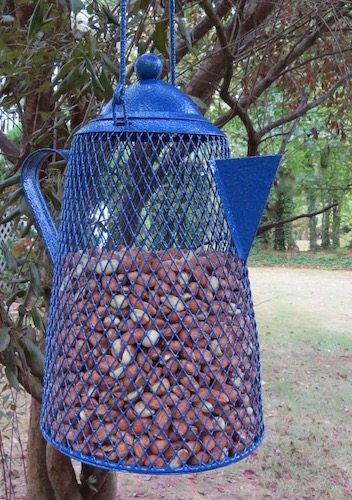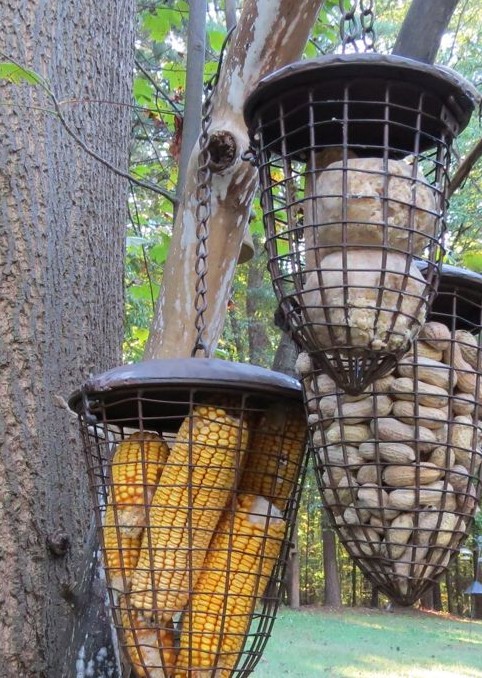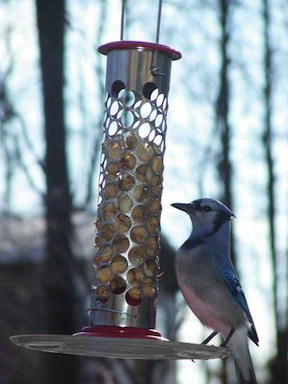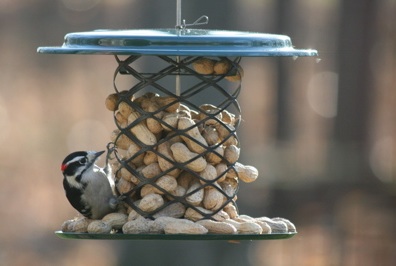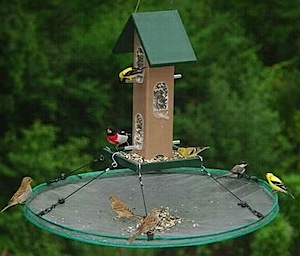-
Peanut Bird Feeders that Rock
Give birds peanuts… because variety is the spice of life!
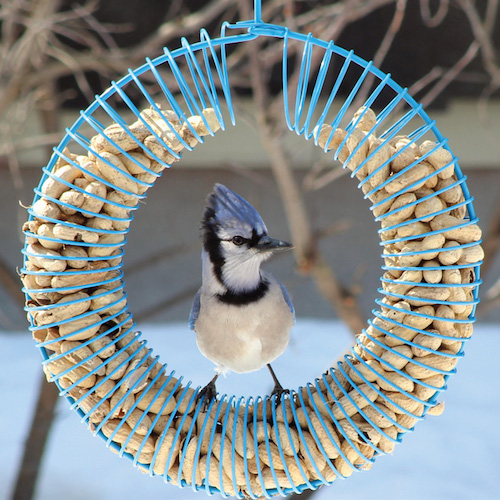 Be it shelled or whole peanuts, birds love them and for good reason. They pack a real punch for nutrition and likely for taste, but you’d have to ask a bird on that one.
Be it shelled or whole peanuts, birds love them and for good reason. They pack a real punch for nutrition and likely for taste, but you’d have to ask a bird on that one.Simply put, Calories = Energy, so especially for cold weather feeding, peanut bird feeders are always a good bet. That energy is what keeps birds warm overnight. Ever wonder why many resident birds feed from dawn till dusk? The goal is to store enough energy to make it through a frigid night.
The Wreath Peanut Feeder above is meant for whole peanuts, but it’s easy to pop a suet ball or two inside for more variety. The design is very bird-friendly and even lends itself for other options.
In early spring, it’s ideal for nesting materials. Start saving your pet’s hair from their brush now. Decorative mosses and feathers are also prime materials for nest construction by most of the usual suspects. Steer clear of dryer lint- though it may seem soft & fluffy, it contains synthetic material that’s just not found in a birds’ world.
Say you could do without the mess of peanuts in the shell? Opt for a feeder that’s made for shelled peanuts. Most of these will accommodate black oil sunflower seed so you can still change it up, enticing more birds to your place.
The large capacity mesh design offers lots of all-over feeding space. Most styles also lend themselves to doing the nest materials in spring. Adding suet may not work as well in shelled peanut bird feeders as there’s nothing to hold it at the outer wall for easy access – though you’ll likely be able to do black oil sunflower for variety.
Regardless if shelled, or peanuts in the shell, birds will flock for this tasty treat year-round. Expect woodpeckers, jays, titmice, chickadees, nuthatches, bluebirds and others at shelled peanuts. Expect squirrels at all peanut feeders… in which case a baffle is highly recommended 🙂
-
Super Sized Peanut Bird Feeders
Lots of birds (and squirrels) adore whole peanuts, especially in colder weather- they pack a punch for higher nutritional value than seed alone. If you’d rather keep squirrels out of peanut bird feeders a baffle is highly recommended!
Ideal for feeding whole peanuts, this wire basket set is versatile for lots of other goodies too. Use these for suet, corn cobs, nesting materials in spring, and even fruit in summer for migratory birds. Use all 3 for peanuts and hang them in different spots around the yard to entice more feathered friends! They feature a long hanging chain with big hook for easy placement (plus enough chain length to accommodate a baffle). The locking lid will keep thieving paws out, and the solid roof helps protect goods from the elements.
There’s also a tube style stainless steel version for whole peanuts which offers an optional seed tray. Inviting more than clinging birds, jays and other can perch in comfort on the 10-inch tray while it helps to catch waste.
It’s actually dubbed as a suet ball feeder, but the large openings are perfect for whole peanuts. So you can really offer a variety of treats in one feeder, mixing some suet chunks or balls between peanuts to delight many a species! Clingers like chickadees, nuthatches, titmice and woodpeckers love this stuff, as well as jays, bluebirds and cardinals (in winter), phoebes, warblers… and the list goes on!
Branch out from traditional feeders filled with boring birdseed and see who comes to visit? And as always, fresh water is key to bringing more birds to the garden. Even during frigid weather, songbirds will absolutely flock to a heated birdbath.
-
Whole or Shelled Nuts for Peanut Bird Feeders?
Depends on who you’re looking to attract? Most clinging birds covet shelled peanuts, in fact almost all birds will go for them. But not all birds are clingers, classified by their ability to grasp a small surface (and their strong feet). Chickadees, nuthatches, woodpeckers and titmice for the most part are considered clingers. The term not to be confused with clingons from Star-Trek 🙂
Adding a tray to peanut bird feeders allows other birds to easily get the goods. Jays adore peanuts, warblers go for them in winter, as will most backyard birds during frigid weather. The tray is inviting, making landing and eating easier.
Larger trays even catch waste from whole peanuts, which folks who could do without the waste might find more appealing. Although when feeding shelled peanuts… there’s really not much waste all. So that alone may influence what’s best to offer at your place! Many shelled peanut feeders offer tray options-but should they not- a universal seed catcher is available to accommodate them.
If the waste from feeding birds is a big drawback, large adjustable seed
trays could be the answer. Attaching to almost any type of feeder, the large 16- or 30-inch diameter promises to catch anything that falls from the feeder. These also create a new feeding space with their large platform area. Peanuts pack a real punch in terms of nutritional value, especially in cold weather. They’re economical if purchased in bulk too. So don’t give up the ship due to the mess some peanut bird feeders may leave behind!

